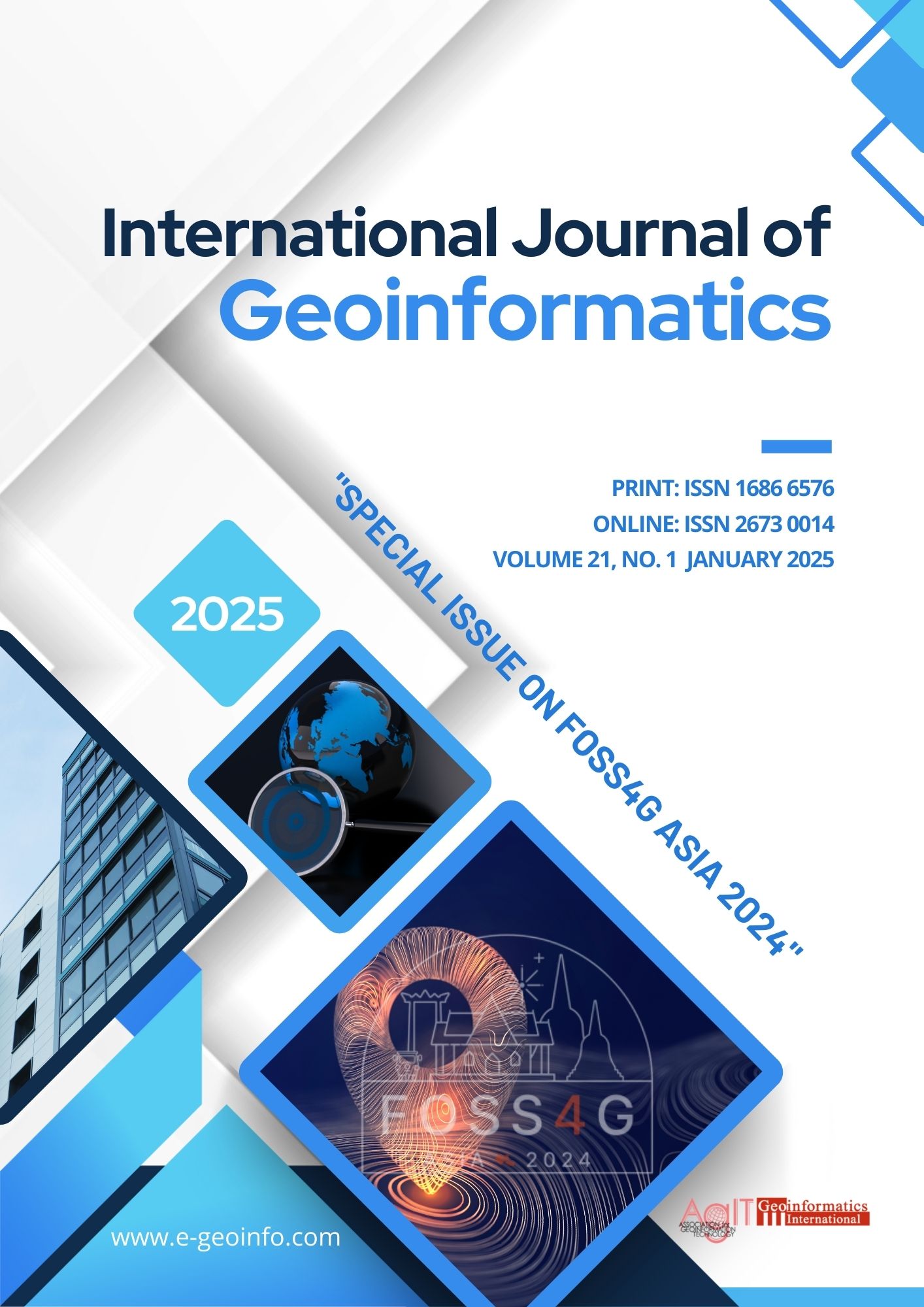Guest Editorial for Special Issue on FOSS4G ASIA 2024
Main Article Content
Abstract
We are witnessing the revolution of geospatial applications with the growing use of Free/Libre and Open Source Software for Geospatial (FOSS4G) technologies. From desktop GIS tools like QGIS and GRASS GIS to web mapping platforms such as GeoServer, MapServer, and OpenLayers, along with big data processing capabilities through Apache Spark, cloud-based environmental analysis in Google Earth Engine, and open data platforms like OpenStreetMap, these technologies collectively demonstrate the immense power and flexibility of open-source solutions in geospatial research. This issue highlights studies which use some of these open and accessible technologies for addressing a wide range of issues, including urban studies, environment and disaster monitoring and management, and agricultural optimization.
This issue contains three interesting articles on urban mobility and urban planning. One article is from Bangkok, Thailand, where the authors used an open-source platform called Apache Spark to analyze GPS data from thousands of taxis. It is about making cities smarter, helping traffic flow more smoothly, and improving urban mobility in ways that were once only possible with expensive, proprietary software. Another fascinating article is the use of 3DWebGIS, which allows urban planners to visualize detailed cities using distributed rendering. Another article highlights an integrated geoinformatics Approach for Real Estate Valuation and Urban Growth.
Open tools and open data are very popular among environment monitoring studies. One of the articles presents the application of Google Earth Engine in tracking and estimating spatial distribution of PM2.5 particles. Using satellite data and open platforms, this research helps locals better understand air quality and its effects on health. Similarly, in the Chi River Basin, authors monitored drought conditions over 20 years with MODIS satellite data, highlighting how open-source tools can be used to tackle the global challenge of water scarcity.
In agriculture, FOSS4G is making a real difference, too. One of the articles demonstrates the development of a low-cost GNSS receiver integrated with IoT for tracking agricultural tractors in real time—an innovative way to improve farm management while keeping costs low. Another research presented mapping of land suitability for sugarcane farming using a combination of fuzzy AHP and open-source evaluation tools, showing that these technologies can provide farmers with more accurate, data-driven decisions to optimize their crops.
Even in areas like coastal ecosystems and groundwater management, FOSS4G is paving the way for better resource management. In this issue, there is one article, where UAV image was used to map coastal ecosystems in detail, providing valuable data for conservation efforts. Similarly, a study in Abuja, Nigeria, applied geophysical analysis to assess groundwater potential, helping local communities understand and manage their water resources more effectively.
Open data and open tools open opportunities for anyone, anywhere, to access the same high-powered geospatial tools used by top researchers and professionals. This shift is all about inclusivity—whether it’s empowering small-scale farmers, environmentalists, or urban planners, these tools are helping people make smarter decisions and create more sustainable solutions. FOSS4G empowers communities with open, accessible tools to collaboratively tackle global challenges and drive sustainable innovation.
Among the many excellent contributions to the conference, the presentation titled "Development of Large-scale Trip Analysis Toolkits for Vehicle-based GPS Trajectories using Apache Spark and Open Data: A Case Study of Taxis in Bangkok, Thailand" by Dr. Apichon Witayangkurn and "Hydrogeophysical Analysis of Vertical Electrical Soundings for Groundwater Potential and Aquifer Vulnerability Evaluation in the Federal Capital Territory, Abuja, Nigeria" by Mr. Danlami Ibrahim were both selected for the Best Presentation Award in Use Case. Additionally, the presentation titled "On the Performance of Distributed Rendering System for 3D WebGIS Application on Ultra-high-resolution Display" by Dr. Tomohiro Kawanabe was selected for the Best Presentation Award in Development. This recognition reflects the outstanding quality, relevance, and innovative approaches demonstrated by these research contributions. The corresponding articles included in this issue highlight the potential of advanced methodologies to address challenges in groundwater assessment, large-scale trip analysis, and high-performance 3D WebGIS applications.
We extend our heartfelt thanks to all authors and reviewers who contributed to this special issue, and we hope these works inspire further advancements in the field.
Dr. Sarawut Ninsawat
Dr. Chomchanok Arunplod
Dr. Chudech Losiri
Dr. Chitrini Mozumder
Article Details

This work is licensed under a Creative Commons Attribution 4.0 International License.
Reusers are allowed to copy, distribute, and display or perform the material in public. Adaptations may be made and distributed.

